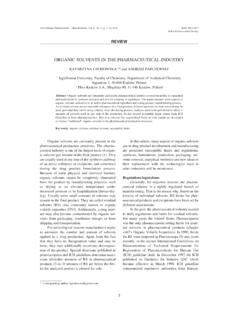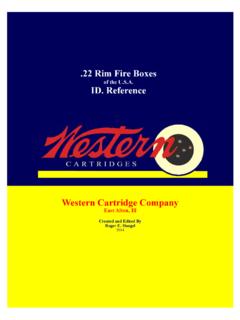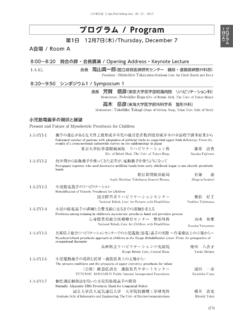Transcription of EVALUATION OF DRUG-EXCIPIENT INTERACTION …
1 Acta Poloniae Pharmaceutica drug Research, Vol. 68 No. 3 pp. 423 433, 2011 ISSN 0001-6837 Polish Pharmaceutical SocietyInteraction between drugs and excipients canalter stability and bioavailability of drugs, thereby,affecting its safety and/or efficacy (1). The success-ful formulation of a stable and effective solid dosageform depends on the careful choice of the excipients (2). The pharmaceutical development of soliddosage forms should imply a previous preformula-tion study of the drug and excipients (3). A numberof experimental techniques ( , DSC, FT-IR spec-troscopy, X-ray powder diffraction, ScanningElectron Microscopy, High Performance LiquidChromatography (HPLC), etc.)
2 Have been used toinvestigate the INTERACTION between drug and excipi-ents (4, 5). These analyses can be applied to provideinformation on physicochemical properties of sub-stances with respect to compatibility by predictingfuture problems of stability prior to the final soliddosage formulation (6). Celecoxib (CXB), nonsteroidal anti-inflamma-tory drug (NSAID), is the first cyclooxygenase-2(cox-2) inhibitor used in the treatment ofosteoarthritis and rheumatoid arthritis in adultpatients. In spite of its high gastrointestinal (GI) per-meability, CXB shows incomplete and poor oralbioavailability.
3 This could be attributed to lowaqueous solubility of CXB, which causes inadequatedissolution in GI fluids and hence poor absorption,distribution, and target organ delivery (7). A majority of the drug absorption in the gas-trointestinal tract occurs in the small intestine (8).Human colon adenocarcinoma (Caco-2) cells arewell characterized and currently most prevalent cellculture systems as a suitable in vitromodel for theintestinal drug transport study (9). Caco-2 cells arealso used to investigate the impact of excipients ondrug absorption, involved mechanisms, absorptionrelated drug - drug /excipient INTERACTION , and associ-ated cytotoxicities (8).
4 The aim of this study was to prepare CXB con-taining tablet formulations and determine the possi-ble interactions between CXB and some excipients (colloidal silicon dioxide (Aerosil ), microcrys-talline cellulose (Avicel PH 102), lactose anhy-drous; magnesium stearate, cross-povidone and talc)which are commonly used in solid dosage formulations were also investigated to showthe effect of DRUG-EXCIPIENT interactions on dissolu-tion and permeability profiles using human colonadenocarcinoma (Caco-2) OF DRUG-EXCIPIENT INTERACTION IN THE FORMULATION OF CELECOXIB TABLETSSIBEL BOZDA -PEHLIVAN1*, B RSEL SUBA 1,2, MRAN VURAL1, NUR EN NL 1and Y LMAZ APAN11 Department of Pharmaceutical Technology, Faculty of Pharmacy, Hacettepe University, Ankara, Turkey2 Refik Saydam National Public Health Agency, Ankara, TurkeyAbstract.
5 In the present study, the possible interactions between celecoxib and some excipients (colloidal sili-con dioxide (Aerosil ), microcrystalline cellulose (Avicel PH 102), lactose anhydrous, magnesium stearate,cross-povidone and talc) were evaluated by examining the pure drug or DRUG-EXCIPIENT powder mixtures whichwere stored under different conditions (25 2OC, 60% RH 5% RH or 40 2OC, 75% RH 5% RH) and dif-ferent period (30 or 60 days) using DSC, FT-IR and HPLC. In order to investigate the possibility of celecoxib-excipient INTERACTION in aqueous medium, dispersions of the pure drug or drug in physical powder mixture (1:1w/w) in water (1%, w/v) were also prepared and evaluated by FT-IR and HPLC at day 0 and day 7 (40 2OC).
6 The INTERACTION between celecoxib and magnesium stearate or colloidal silicon dioxide were determined in theaqueous dispersions by FT-IR. Different tablet formulations with or without excipients tested were prepared,and assessed for drug dissolution and permeability. Keywords: Celecoxib, DRUG-EXCIPIENT INTERACTION , permeability, Caco-2 cells423* Corresponding author: e-mail: ++903123051241; fax: ++903123114777424 SIBEL BOZDA -PEHLIVAN et was obtained from Fako Pharm. Co.(Turkey). Lactose anhydrous, magnesium stearateand talc were supplied from Merck (Germany).Colloidal silicon dioxide (Aerosil 200) and micro-crystalline cellulose (Avicel PH 102) were pur-chased from Degussa (Germany) and SelectchemieAG (Switzerland), respectively.
7 Cross-povidonewas supplied from GAF Chem. (USA).Caco-2 celllines were purchased from American Type CultureCollection (USA). L-glutamine, fetal bovine serum(FBS) and penicillin G sodium-streptomycin sulfatesolution were provided by Biochrom (Germany).All other chemicals were obtained commercially asHPLC or analytical grade methodsAssay of celecoxibDetermination of CXB was performed byHPLC according to the modified method of Abdel-Hamid et al. (10). The modular HPLC consisted ofHewlett Packard Co. Model 9012 constant flowpump, a Varian Co. Model 9100 autosampler andHewlett Packard Co.
8 Chromatography were analyzed on a Phenomenex C18column (5 mm particle size, 25 cm mm ) and CXB was quantitated in a VarianCo. Model 9050 UV detector set at 254 nm. Themobile phase consisted of methanol : 1% acetic acidsolution (80:20, v/v) and was run through the HPLC system at a rate of mL/min at room peak area used throughout this study and thechromatographic method were validated by lineari-ty, sensitivity, precision, accuracy and specifity. Differential scanning calorimetry (DSC)DSC experiments were carried out with aDuPont Ins.
9 9900 Computer Thermal Analyzer(USA). Samples about 3 mg were weighed inpierced Al pans and scanned under static air over atemperature range of 25 205OC at a heating rate of10OC/min, and the thermograms were reviewed forevidence of any INTERACTION . Entalpy calculationswere completed using TA-60 software ( ).Fourier transform-infrared spectroscopy (FT-IR)Fourier Transform-Infrared Spectra wererecorded on a Nicolet 520 (USA) apparatus usingKBr discs in the range of 4000 400 cm-1. The spec-trum was a mean of ten consecutive scans on thesame methodsPreparation of physical powder mixturesIn order to evaluate the CXB-excipient interac-tion in solid state mixture, physical powder mixturesof drug and some excipients were cellulose (Avicel PH 102) (MCC),colloidal silicon dioxide (Aerosil 200) (CSD), lac-tose anhydrous (LA), magnesium stearate (MS),cross-povidone (CP) and talc (TA) were used asexcipients.
10 The drug : excipient (1:1, w/w, totalamount: 500 g) were firstly homogeneously mixedwith a pestle in a mortar, and blended in a laborato-ry powder mixer at 50 rpm (Erweka AR 400 CubeBlender, Berlin, Germany) for 10 min, then powdermixture was placed in a glass vial with rubber composition of the physical powder mixturesare shown in Table of dispersions of physical powder mix-turesAqueous dispersions of physical powder mix-tures of CXB and the excipients were prepared toexamine the DRUG-EXCIPIENT INTERACTION in aqueousmedium. The dispersions were prepared by additionof CXB (1%, w/v) or DRUG-EXCIPIENT physical pow-der mixtures (1:1, w/w) (1%, w/v) to distilled waterunder continuous stirring until the powders werecompletely dispersed.

















